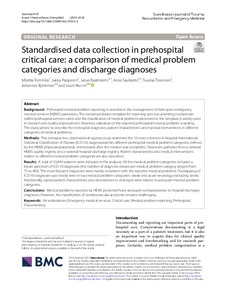Standardised data collection in prehospital critical care: a comparison of medical problem categories and discharge diagnoses
Tommila Miretta; Pappinen Jukka; Raatiniemi Lasse; Saviluoto Anssi; Toivonen Tuukka; Björkman Johannes; Nurmi Jouni
https://urn.fi/URN:NBN:fi-fe2022081154267
Tiivistelmä
Background
Prehospital medical problem reporting is essential in the management of helicopter emergency medical services (HEMS) operations. The consensus-based template for reporting and documenting in physician-staffed prehospital services exists and the classification of medical problems presented in the template is widely used in research and quality improvement. However, validation of the reported prehospital medical problem is lacking. This study aimed to describe the in-hospital diagnoses, patient characteristics and medical interventions in different categories of medical problems.
Methods
This retrospective, observational registry study examined the 10 most common in-hospital International Statistical Classification of Disease (ICD-10) diagnoseswithin different prehospital medical problem categories, defined by the HEMS physician/paramedic immediately after the mission was completed. Data were gathered from a national HEMS quality registry and a national hospital discharge registry. Patient characteristics and medical interventions related to different medical problem categories are also described.
Results
A total of 33,844 patients were included in the analyses. All the medical problem categories included a broad spectrum of ICD-10 diagnoses (the number of diagnosis classes per medical problem category ranged from 73 to 403). The most frequent diagnoses were mainly consistent with the reported medical problems. Overlapping of ICD-10 diagnoses was mostly seen in two medical problem categories: stroke and acute neurology excluding stroke. Additionally, typical patient characteristics and disturbances in vital signs were related to adequate medical problem categories.
Conclusions
Medical problems reported by HEMS personnel have adequate correspondence to hospital discharge diagnoses. However, the classification of cerebrovascular accidents remains challenging.
Kokoelmat
- Rinnakkaistallenteet [27094]
